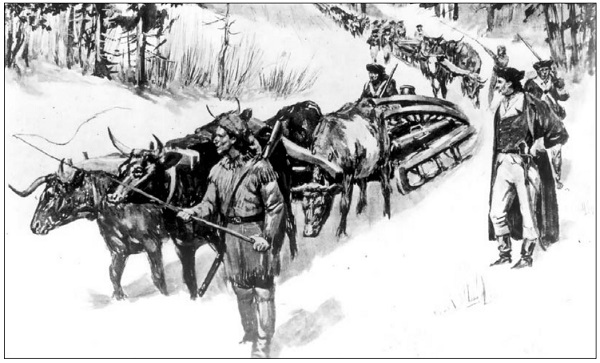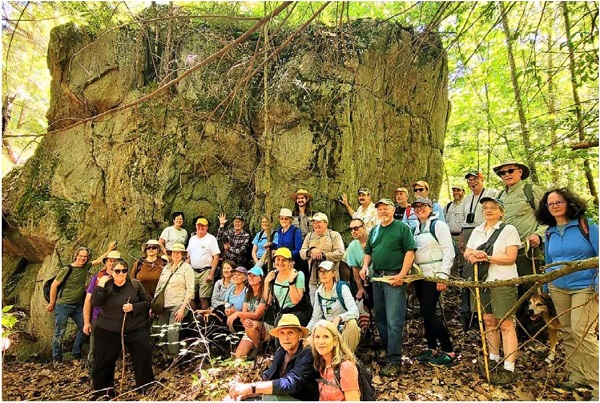| The Sandisfield Times |
|---|
| National Spotlight on Sandisfield’s Knox Trail America250 Could Introduce the U.S. to Our Town |
|
by Ron Bernard Published July 1, 2024. |

|
|
Sandisfield’s most important historical legacy is about to get long-overdue recognition on a national scale. The Knox Trail meanders over about 4 miles of the heavily reforested Beech Plain section of Sandisfield. While its existence is appreciated by historians of early America and to some extent communities in upstate New York and Massachusetts, the Knox and its significance is relatively unknown elsewhere. That may soon change. The surviving stretch of the original Trail crosses Sandisfield into Otis. It is thought to be the only undeveloped segment of the ancient road that once connected the Dutch settlement of Albany with Boston. Its obscurity is probably due to its remoteness and its lightly populated territory which produced very few written mentions. America250 Could Focus Attention Here The country’s 250th birthday is coming up in 2026. In 2021, Congress established the Semiquincentennial Commission, known as “America250,” to conduct a national awareness campaign about the founding of the country in 1776. Thirty-eight states have partnered in America250, reportedly the most extensive commemoration project in U.S. history. The Massachusetts 250th American Revolution Commission (“Mass250”) has 35 members including leaders in history and tourism. Because the state’s role in the Revolution was especially significant, the spotlight could be particularly bright here.
 Hauling cannons by ox team from Fort Ticonderoga for the siege on Boston, Henry Knox and teamsters passed through northern Sandisfield. (Department of Defense, Department of the Army, Office of the Chief Signal Officer, National Archives.) The Knox Trail was made legendary by Col. Henry Knox and his soldiers who in late-1775 captured cannons from the British at Fort Ticonderoga in upstate New York. In a super-human feat of resolve and endurance Knox’s teamsters dragged the heavy cannons for weeks over hundreds of miles of primitive road during mid-winter to reach a besieged General Washington at Dorchester Heights who was facing the menacing British fleet below in Boston harbor. When Washington trained his guns on the harbor a flabbergasted Admiral pulled up anchors and the fleet retreated without a shot being fired. Some historians believe this was a seminal event – if not the seminal event – in the Revolution which might have otherwise ended in disastrous defeat for Washington and his fledgling army of Patriots then and there. The hope is that the Knox Trail in Massachusetts could join, for example, Bunker Hill and finally get appropriate recognition and a rightful place in this epic story. An Untold Story Known by almost two dozen colloquial names, the Knox Trail was a footpath and roadway long before its role as a “war road” in the 18th century. For centuries the trail connected Mohicans from the Hudson Valley to hunting grounds in the Berkshires, including Sandisfield. It also allowed for trading with tribes from central Massachusetts and probably eastern Connecticut. In the colonial period the road was important for fur traders, explorers, and English settlement. (For a related article and list of the road’s many names, see Sandisfield Times, May 2021, pages 8-9. Go to Sandisfieldtimes.org/library/archives). Identification of this last original and virtually undeveloped segment of the Knox Trail and why it is being celebrated today is due totally to the determination of one person, Otis resident and retired DCR employee Tom Ragusa. For more than thirty years, Tom researched and documented the Sandisfield-Otis section in mostly heavily reforested terrain and he spent twelve years to meticulously map the original roadbed. Charlie Gould, Visual Informational Specialist for the National Park Service (Mass.), recently visited the trail. He told The Times, “This road is truly amazing and remarkably well-preserved – much better than I expected. You really feel that you are treading in the footsteps of history.” Kelly Fellner, superintendent of the National Park Service office in Springfield, has also toured the Knox. She said, “As we approach the 250th anniversary of the American Revolution, it is important that we find ways to commemorate not just the events, but also the diversity of ideas and people during that period. And the fact that there are tangible reminders, like the Knox Trail, where portions have not been altered or covered over, is an opportunity for us to walk in their footsteps and reflect on the people and history of the place.”
 Last month an enthusiastic group completed a rigorous trek in the footsteps of Knox's teamsters almost 250 years ago. Led by trail expert/researcher Tom Ragusa, the group is pictured here at Abiel's Rock in Sandisfield. Imposing and legendary, Abiel's rock is a major historical waypoint on Knox Trail. (Photo: Western Massachusetts Hilltown Hikers.) Where is This Trail and Can We Hike On it? The trail is rough, not marked and is not currently available to the general public. Most of the Sandisfield section lies in protective Otis State Forest, but at least one portion passes through private property (no standing permission at this time). General access is a goal and may happen one day but for now interested hikers adept at bushwhacking and stream-leaping should be alert for rare announcements from Tom Ragusa or Hilltown Hikers (www.hilltownhikers.com) about upcoming dates (limited, first come basis). Jump-off point is upper Spectacle Pond. Hikes are about five miles long, duration about four hours. The trek is considered rigorous for casual hikers, and there are no amenities along the way. The exit point is Route 8 by the Farmington River in Otis. |

|
©The Sandisfield Times. All rights reserved.
Published July 1, 2024